The state-sanctioned program of Political Chess begun by Alexander Ilyin-Genevsky and elaborated by Nikolai Krylenko was but one of several parallel projects aimed to promote socialism in the fledgling Soviet Union. Another such effort was Soviet Constructivism and its VKhUTEMAS Institute, an acronym for Vysshie Khudozhestvenno-Tekhnicheskie Masterskie (Higher State Artistic and Technical Studios), founded in 1920 by the merger of the Moscow School of Painting, Sculpture and Architecture and the Stroganov School of Applied Arts. Like the Bauhaus, it combined industry, architecture, design, and art under one roof. Among its famous faculty were Konstantin Melnikov (architect), Aleksandra Ekser (“color in space”), Alexander Rodchenko (construction), Nadezhda Udaltsova (“volume in space”), Varvara Stepanova (textiles), and Alexei Gan (graphic design). In Stepanova’s words, the Institute’s goal was to devise “methods for a conscious awareness of the demands imposed on us by new social conditions.” “Art is dead!” proclaimed Gan, “There is no room for it in the human work apparatus. Work, technique and organization!” J. Willette, Constructivism and the Avant Garde (2020).
According to art historian Laura Hillegas, “The Constructivists sought to influence architecture, design, fashion, and all mass-produced objects. In place of painterly concerns with composition, Constructivists were interested in construction. Rather than emerging from an expressive impulse or an academic tradition, art was to be built.” Constructivism Brought the Russian Revolution to the Art World. Constructivist design employed pure geometric forms, linearity, symmetry, repetition, simple, sans-serif fonts, the dominance of red and black, and photomontage. FINSA, What is Russian Constructivism?
Many of these elements can be seen in El Lissitzky’s famous poster, Reds into Whites (1919):
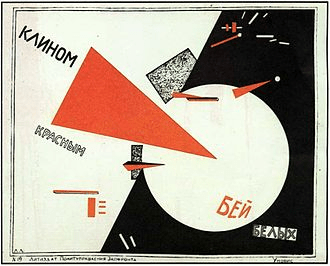
Constructivist elements abound in graphic art associated with Soviet chess of the 1920s and 1930s. Here is the cover of a popular chess book from 1925.
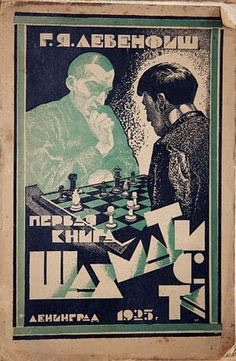
There are no known examples of a purely Constructivist Soviet chess set, but Rodchenko designed a chess table in 1925 for a Worker’s Club:

Wiki Commons photo.
It then should come as no surprise to find Constructivist elements appearing in Soviet chess set design. The constructivist influence is heavy in these small, unweighted pieces likely of the 1930s, whose kings stand a mere 63 mm tall.

The bishops combine a sphere and a cone. The pawn is a sphere resting upon a stem that flows organically from the disc-shaped base unobstructed by a collar. The royals share a thick, hyperbolic, dendraformic stem, noticeably narrower at the bottom than at the top in defiance of neoclassical notions of “common sense,” where the bottoms of columns are “naturally” wider than their tops. The geometry of the royals’ stems is echoed in the dendraformic structure of the rook. “Common sense” is literally stood upon its head.
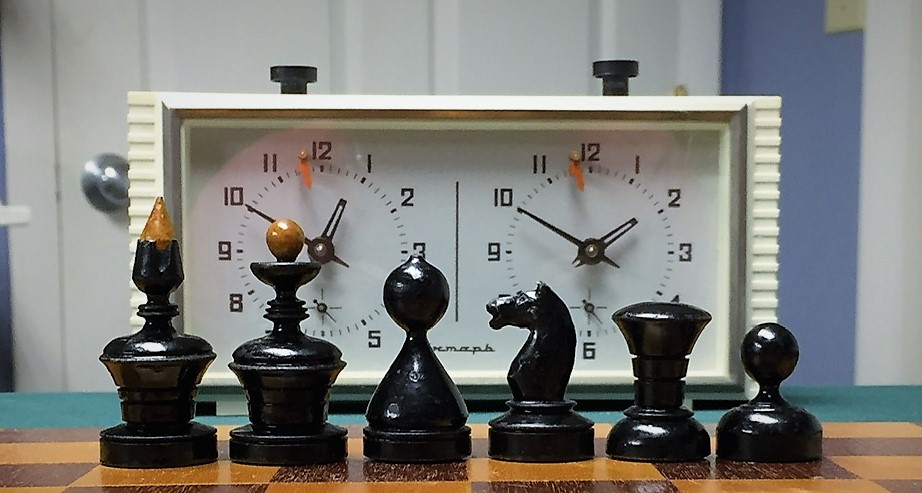
The royals’ pedestals echo the form of the pawn’s base, their crowns attached by a double-collared connector. The king’s crown is composed of triangles and topped with a bullet-shaped finial. The queen’s crown inverts and repeats the pawn base structure, and is topped by a sphere. The only Staunton elements evident are the collared royal connectors and the relative sizes of the pieces.

Pieces in this Constructivist-influenced design were made in at least two sizes. Here is the 65 mm king version compared side-by-side with a larger 85 mm version.
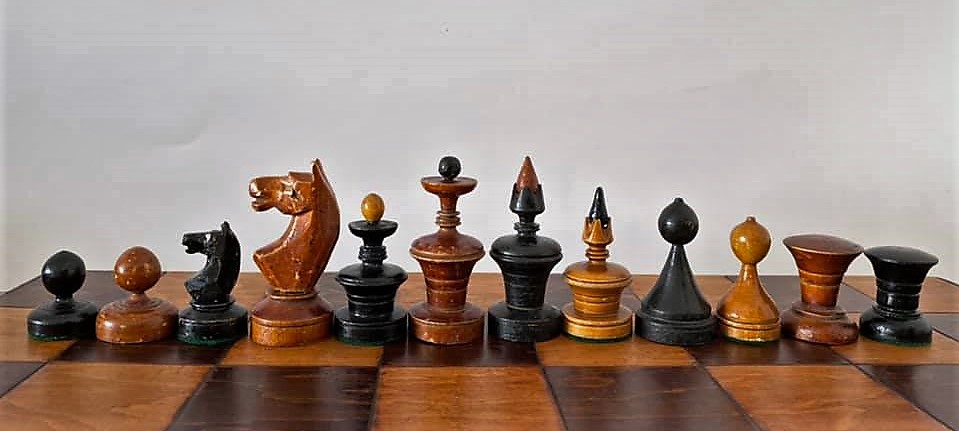
The pieces of this set bear a remarkable resemblance to those found in a Constructivist flyer for the well-known 1925 Soviet film Chess Fever, starring World Champion Jose Raul Capablanca and other participants of the 1925 First Moscow International Chess Tournament, itself a manifestation of the Soviets’ program of Political Chess. The film, with English subtitles, can be viewed in its entirety here.

The pieces also appear in the photographic record from the 1930s. Here is a photo found by collector Sergey Kovalenko of Grandmaster Emeritus Vladimir Alatortsev (1909-1987) playing in a simultaneous exhibition with what seems to be the larger version of the set in the foreground.
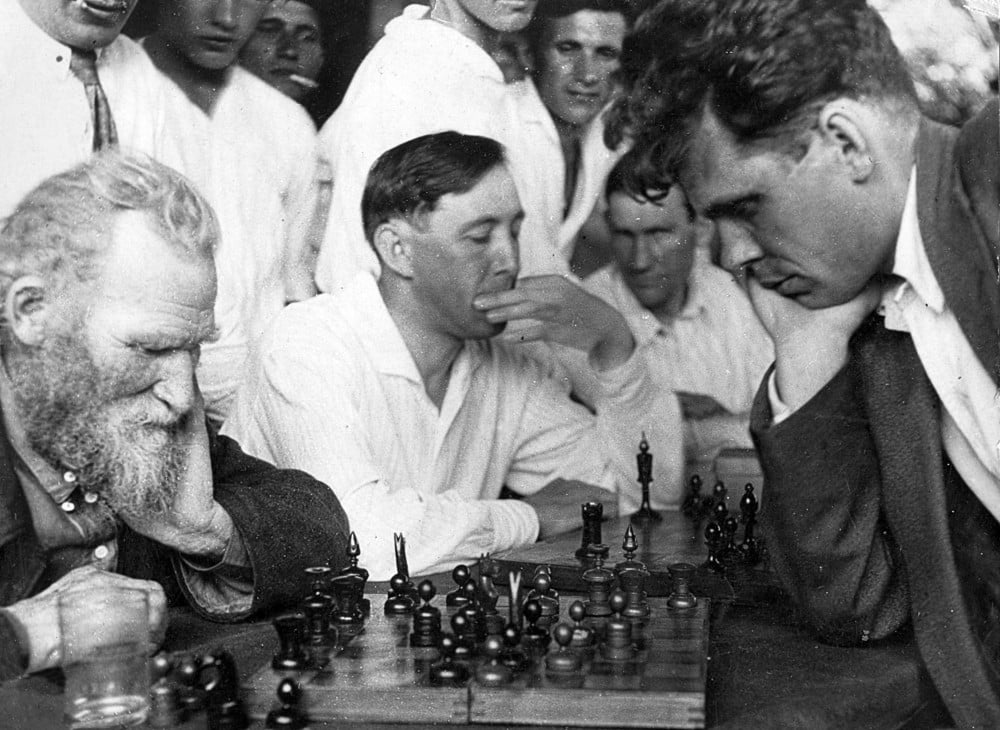
My specimen of this design came inside a small wooden board/box similar to that appearing in the Alatortsev photo. The coordinates were added by a prior owner.

The inside of the box bears a stamp indicating that it was manufactured by the Moscow State Toy Factory, with a Moscow street address.

It’s from the Chess Fever flyer and Alatortsev photo that I date the set.
Many other Soviet sets bore Constructivist influences. I’ve already discussed the impact of modernism on the Botvinnik-Flohr II design here. It is a theme to which we will return.


I really enjoy your articles. Keep them coming!! I collect early American sets, but your collection is fascinating!
LikeLiked by 1 person
Many thanks, Bruce. What are your favorite early American sets? I have a c. 1900 American Chess Company set that I really like.
LikeLike